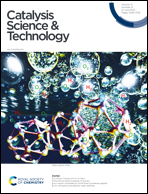Graphdiyne (CnH2n−2) coupled with ZnCo-MOF double S-scheme heterojunction forms an efficient electron transport layer and its characterization via in situ XPS
Abstract
Graphdiyne (GDY) is a new material, which is formed by the combination of sp and sp2 heterojunctions with a 1,3 diacetylene bond attached to a phencyclidine ring. Furthermore, it has several advantages including good electrical conductivity, tunable electronic structure and uniform three-dimensional void structure. In this study, GDY was synthesized via organic synthesis, and subsequently a GDY/CuS/ZnCoS2 double S-scheme heterojunction was constructed and its successful preparation confirmed by SEM, TEM and XPS characterizations. The two-dimensional lamellar GDY offered a large area to load ZnCoS2 and CuS, and the ternary composite catalyst exhibited a superior hydrogen production performance because of the special charge distribution of GDY, enabling it to act as an electron acceptor or donor. With the combination of ZnCoS2 with GDY, the hydrogen production capacity of the ternary catalyst significantly improved. In the presence of a sacrificial reagent, TEOA (15 vol%), pH = 9 and illumination from a 5 W LED lamp, the hydrogen production reached 61.67 μmol in 3 h. The effects of charge transfer and possible reaction mechanisms during hydrogen generation were studied by photoelectrochemistry and XPS. This work further promotes the development of GDY in the field of photocatalysis and contributes to the further maturation of S-scheme heterojunctions.



 Please wait while we load your content...
Please wait while we load your content...